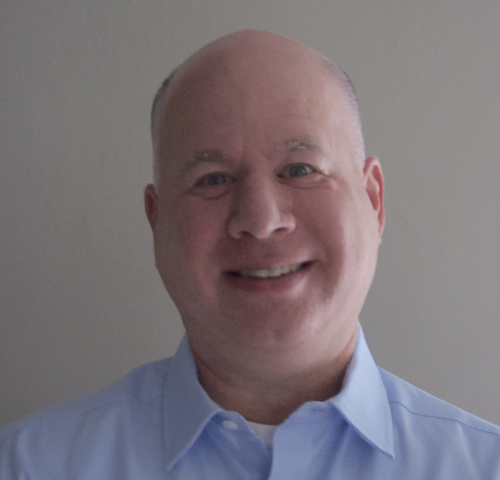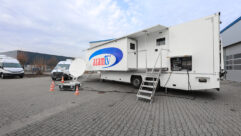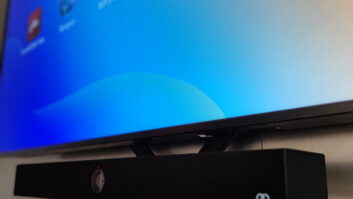

Santa Barbara – September 2018… Lewis Eig, Visionary Solutions’ new Director of Business Development, is an AV force to be reckoned with. Over the past quarter century, he’s worked in almost every facet of the industry, from designing and installing systems to consulting with top architects and integrators to founding AV Register, the definitive guide to the top integrators around the world. We sat down with Lewis to get his perspective on the state of video-over-IP and preview new technologies coming from Visionary Solutions.
What drew you to Visionary Solutions?
I had been paying attention to Visionary for many years. My history in the ’90s with Crestron’s first Ethernet-enabled control processors, even before I worked for the company, made me hyper-aware of Ethernet-based trends in pro AV, not just in the convergence movement. Later, my roles at both NetStreams and ClearOne included a significant amount of market research, and I always identified Visionary as being a significant innovator in this space. Watching the company come from the IPTV market and hone its offerings to the JPEG2000/Duet products and very innovative Dante solutions, including PoE based amplifiers, made me realize Visionary would dominate the market.
You have a broad background, with experience in product development and channel marketing, even technical management. How did all of that prepare you for your new role?
I’ve always been extremely hands-on. In high school, I signed on to be an intern at a high-end car stereo shop because I wanted a part-time job after school and on Saturdays. I guess this launched me into low-voltage and pro A/V. After college, with a degree in radio/TV and film, I ended up in Orlando and found my way to an A/V shop that had a small division of residential and pro A/V installations. The integration firm I was managing, Image Technical Services, programmed the first classrooms—and some of the first rooms anywhere in the world—with Crestron’s Ethernet plug-in card for control. Crestron offered me the role of consultant liaison, which led to many relationships that I’ve maintained almost 20 years later. It was my engineering efforts, and technical aptitude that consultants appreciated: They knew that when I came for a visit, the time spent would be valuable, educational, and technical. My various roles in the pro A/V space, from integrator, to consultant, to sales, engineering and product development roles, means that I can relate to any audience in any meeting, and the people I meet with appreciate my offerings.
Can you share some insight on what we’ll be seeing from Visionary Solutions in the coming year?
Visionary Solutions is a pioneer in streaming. We are not resting on our laurels. We are in the final stages of developing a wall-plate encoder solution that will provide the highest-quality encoding, reliability, and cost effectiveness that the industry expects from Visionary. We are also excited to be releasing Sentinel, a networked-AV monitoring solution, providing simple and economical Dante and AES67 monitoring and alerting. On the hardware side, our next-generation stand-alone encoders and decoders will have many of the advanced features our partners have requested. Our product development is driven by real-world applications.
As a client-facing organization, Visionary thrives on listening to the needs of those who use our products; our development of new products stems from these conversations. We are very grateful for the consultants, integrators, manufacturers’ representatives, and manufacturer partners, who are all responsible for shaping future product development.
What AV integration trends are you most excited about?
We are finally seeing AV as an important consideration in building/facility management. This is an exciting trend, for AV systems used to be stand-alone and fairly insignificant. Today, it’s hard to imagine a space that doesn’t have some audio and some video as the focal point. The trend toward IoT (Internet of Things) is something I have kept on my radar; however, as news stories tell us all too frequently, privacy and security concerns give government and corporate executives great trepidation about installing these devices. There is no doubt the pro AV market will experience its share of IoT devices in coming years. Even more interesting to me is the AR/VR space; its impact on pro A/V will be huge. Google Glass and AR/VR/MR/XR headsets could eliminate the need for displays everywhere we are used to seeing them. How do you get the content to these devices? It’s streamed, of course. Signal quality, reliability, low latency, ease of control, and platform standards all become critical.
Here’s one fun question: What would people me most surprised to learn about you?
My first job out of college put me in the role of “Lead Laserist” for a touring/mobile laser lightshow company. I had absolutely no experience with lasers, nor with the hardware or software used to make it all work. Despite tons of technical troubles and broken equipment, we never missed a show. I toured the country with an audio assistant performing Laser Zeppelin, Laser Floyd, Laser Grunge, and more. We performed at many historic theaters and arenas, we did outdoor events, we even did the laser accompaniment to the Cincinnati Pops Orchestra. Over the course of three years we crossed the country countless times; we performed between three and five laser shows a week, almost every week of the year.










